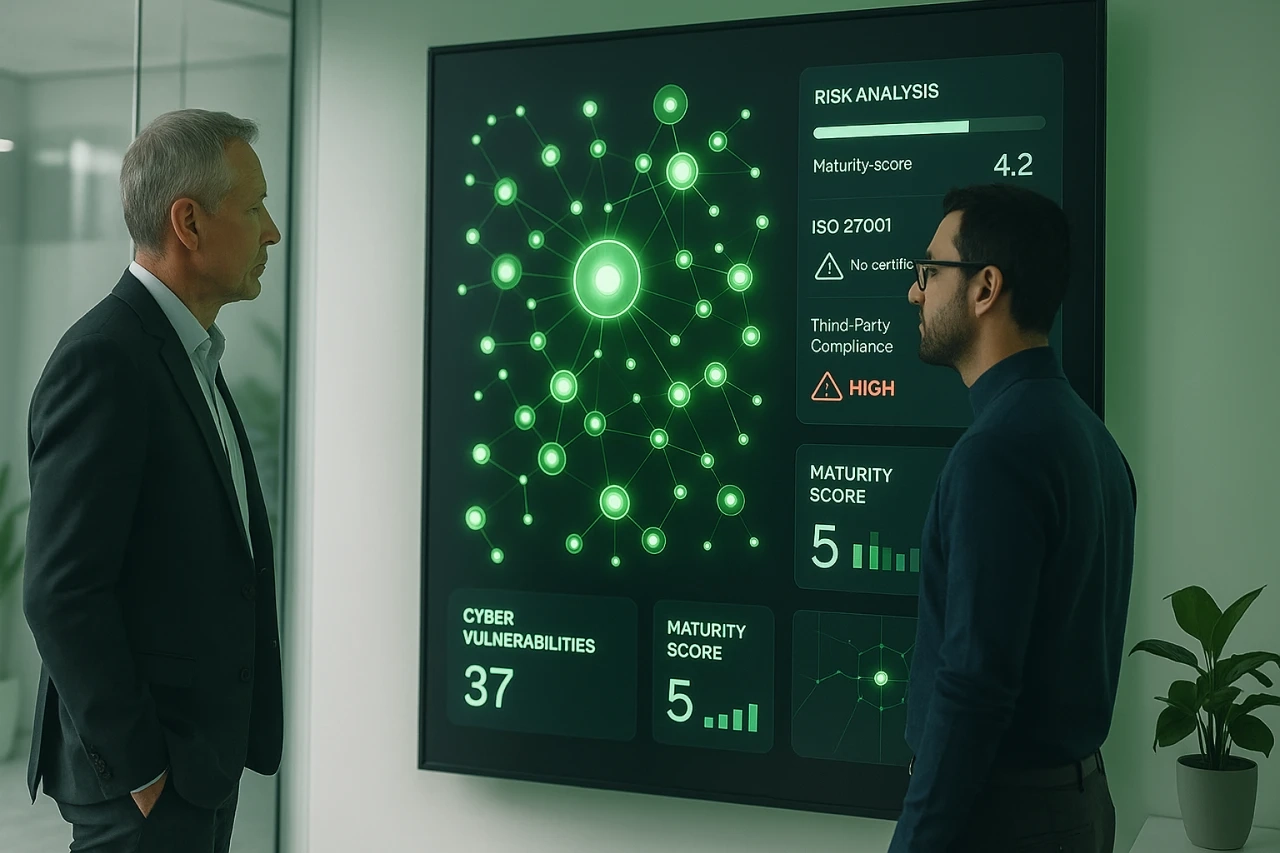DORA and NIS 2: Optimizing Governance of Critical Third Parties

USD 9.5 trillion: that’s the estimated global loss from cybercrime in 2024, according to the World Economic Forum. If cybercrime were a country, it would be the world’s third-largest economy. In France, losses from cyberattacks are estimated at €100 billion in 2024.
These two major regulations—the DORA (Digital Operational Resilience Act) and NIS 2 (Network and Information Security Directive 2)—transform how we approach cybersecurity and regulatory compliance. They establish a fortified framework for the operational resilience of critical European infrastructures. Achieving regulatory optimization requires a unified approach to third-party risk assessment and management, based on a four-step methodology: identification, assessment, monitoring, and continuous improvement.
DORA: Evaluating the Resilience of Your Financial Partners
The DORA regulation, effective from 17 January 2025, strengthens digital business continuity for European financial entities. It requires institutions to build resilient recovery systems for major cyber disruptions.
DORA’s primary goal is to ensure continuous financial operations during serious incidents. Risk management becomes vital—encompassing threat protection and robust recovery strategies. As Atos explains, affected entities must conduct regular self-assessments and independent audits of their ICT risk frameworks.
Operational Resilience as a Priority
Organizations must focus on stability to meet DORA’s objectives—developing rapid-response emergency plans for incident recovery. Financial institutions should continuously evaluate their supply chain security to detect and mitigate vulnerabilities. Governance and internal controls must align with DORA—integrated with collaborative third-party evaluations to reinforce ecosystem-wide resilience.
In banking, such methodology is applied through systematic assessments of critical cloud providers and resilience testing of technology partners. European banks are now building collaborative evaluation programs to share best practices while maintaining regulatory compliance.
DORA: Secure Your Critical Financial Partners Now
Learn how to streamline your DORA compliance with a collaborative assessment process for critical financial partners.
NIS 2: Third-Party Governance in Critical Sectors
The NIS 2 Directive revolutionizes European cybersecurity by significantly widening its scope. Unlike DORA’s focus on finance, NIS 2 now covers 18 critical sectors, affecting around 300,000 institutions across the EU. Its strategic expansion aims to harmonize cybersecurity efforts and strengthen the operational resilience of essential infrastructures.
This directive redefines risk management by replacing former Operators of Essential Services (OES) with two new categories: essential entities and important entities. Obligations vary depending on criticality, with penalties reaching €10 million or 2% of global turnover for essential entities.
Mapping Third Parties per NIS 2 Classification
NIS 2 extends to:
- Highly critical sectors: energy, transport, banking, financial market infrastructure, health, water supply, wastewater, digital infrastructure, public administration, and space.
- Other critical sectors: postal/courier services, waste management, chemical production/distribution, agri-food, and digital providers.
This reflects a collaborative third-party governance approach that goes beyond internal protection. Companies must now implement structured third-party evaluation methodologies, including enhanced technical and organizational measures across their ecosystem.
NIS 2: Anticipate Risks by Assessing Your Critical Partners
Assess your critical partners’ maturity against NIS 2 criteria via our collaborative evaluation platform Aprovall360.
Risk Management and Incident Notification
A core element of NIS 2 focuses on enhanced risk management for third parties, underpinned by Third‑Party Risk Management fundamentals, to structure collaborative evaluation.
Companies must establish protocols to detect, analyze, and neutralize threats before they disrupt value chains. This entails continuous supplier risk assessments and increased monitoring of strategic providers.
Employee training is also mandatory, ensuring staff can recognize warning signs of potential attacks, particularly from third parties. These human factors are critical to maintaining ecosystem-wide operational resilience.
Reporting Obligations and European Coordination
NIS 2 mandates proactive incident reporting within specified timelines. Major incidents involving critical third parties must be notified to competent authorities, enabling effective coordinated responses across Europe. This harmonization facilitates essential information sharing among stakeholders in the face of growing cyber threats.
In industry, this means systematic assessment of ICPE sites and critical suppliers with a focus on supply chain security. Industrial players are deploying continuous surveillance programs to quickly identify vulnerabilities among strategic partners.
In the public sector, these rules strengthen public procurement governance and collaborative assessment of critical suppliers, as shown by TPRM deployments in the public sector. Local authorities are implementing continuous evaluation processes to ensure regulatory compliance and service quality.
NIS 2: A Collective Approach to Securing Your Critical Third Parties
Strengthen your NIS 2 compliance with a shared-third-party assessment strategy tailored to sector-specific requirements.
Aligning Third-Party Assessment: DORA/NIS 2 Approach
Harmonizing DORA and NIS 2 is a strategic challenge for EU organizations operating in multi-sector ecosystems. This multi-regulatory integration demands a collaborative methodology, transcending mere juxtaposition of obligations to create truly unified third-party governance.
The complementarity is clear: Yogosha describes DORA as the “lex specialis” of NIS 2—specific rules overriding general law. DORA complements rather than replaces NIS 2, forming a coherent framework for collaborative assessment of critical third parties.
Four-Step Optimization Methodology
ENISA’s structured methodology outlines:
- Identification – Mapping critical third parties, assessing vulnerability
- Assessment – Collaborative risk evaluation per DORA/NIS 2
- Monitoring – Automated continuous monitoring
- Continuous Improvement – Process optimization based on feedback
Governance Strategy
Strong governance and internal control are foundational to successful multi-regulatory integration. Flexible frameworks are needed to adapt to evolving legislation while ensuring business continuity. A proactive approach includes persistent monitoring of regulatory changes at all organization levels.
Unified supplier control processes allow companies to maintain compliance while enhancing overall cybersecurity posture. Industrial sectors implement collaborative evaluation programs that satisfy NIS 2 infrastructure requirements and operational resilience standards mandated in other sectors.
In construction, multi-regulatory integration helps align subcontractor certifications with procurement compliance, enhancing chain security.
One Compliance, Multiple Regulations: A Single Effective Method
Optimize your multi-regulatory compliance using a unified approach to third-party assessment tailored to specific sectors.
TPRM Driving Compliance
Rapid technological advances are providing tools to meet DORA and NIS 2 requirements through collaborative third-party governance. Companies that adopt advanced automated evaluation tools—including essential TPRM platform features—can better secure systems and improve compliance effectively.
AI-powered monitoring platforms analyze inbound and outbound data to detect signs of malicious behavior among critical third parties. Such systems promptly alert security teams, enhancing incident response and strengthening organizational robustness across the ecosystem.
According to ENISA, technical and methodological cybersecurity measures must be fully implemented by covered entities. This collaborative auditing of critical third parties relies on advanced technologies to automate verification and continuous monitoring.
ENISA’s National Cyber Security Strategy guidance also recommends “harmonized information security policies” to establish a common language between public authorities and private organizations, reducing administrative duplication.
In retail, automatic marketplace analysis evaluates vendor compliance in real time, helping maintain supply chain security via AI-powered tools.
They Did It: Feedback on Third-Party Governance
Explore sector-specific customer success stories on how others have optimized their third-party governance.
Intelligent Workflows for Third-Party Assessment
Automation is crucial for compliance optimization. Automating repetitive third-party evaluation processes not only reduces human error but frees up time for strategic third-party governance work.
Companies must adopt flexible IT architectures capable of adjusting to frequent DORA and NIS 2 updates. This ensures evaluation systems stay effective and secure without disrupting risk management.
According to ENISA, SMEs employing simplified risk management methods can reduce repetitive evaluation time by 60% while improving control quality.
Automated evaluation workflows also standardize governance and internal control processes, yet allow sector-specific flexibility. The paid mutual “pay-to-collect” model can reduce administrative costs by 40%.
DORA / NIS 2 : automatisez votre conformité, réduisez vos coûts
Discover how automation can reduce your DORA/NIS 2 compliance cost and streamline workflows.
A Strategic Investment for the Future
Optimizing DORA and NIS 2 compliance is more than a regulatory requirement—it’s a strategic investment with long-term returns. ENISA notes that organizations who mutualize security evaluations save substantially by avoiding audit duplication and better allocating compliance resources.
By embracing a collaborative third-party evaluation approach, European organizations not only reinforce their operational resilience, they also build sustainable competitive advantage in a constantly evolving regulatory landscape. Collaborative third-party governance thus becomes a strategic lever to anticipate future challenges and maintain operational excellence.
These articles might interest you
-
 01 July 2025Cyber Risk Among Suppliers: A Strategic Priority for Procurement TeamsSecteurAs a single cyberattack can now paralyze an entire production line, identifying cyber vulnerabilities within your supplier network is no longer optional. It has become a strategic lever, at the intersection of business continuity, compliance, and operational resilience. Data That Speaks for Itself Between 2021 and 2023, business disruptions caused by cyberattacks targeting suppliers surged […]
01 July 2025Cyber Risk Among Suppliers: A Strategic Priority for Procurement TeamsSecteurAs a single cyberattack can now paralyze an entire production line, identifying cyber vulnerabilities within your supplier network is no longer optional. It has become a strategic lever, at the intersection of business continuity, compliance, and operational resilience. Data That Speaks for Itself Between 2021 and 2023, business disruptions caused by cyberattacks targeting suppliers surged […]Read more
-
 18 August 2025Reindustrialization: Why Mastering Third Parties Is Now a Strategic ImperativeSecteurFrance’s reindustrialization is underway. Driven by the ambitions of the France 2030 plan, the ecological transition, and economic sovereignty challenges, it’s about much more than simply bringing factories back onto national soil. It requires a deep rethink of sourcing, evaluation, and supplier management processes. Restoring independence and economic sovereignty has become a major strategic issue […]
18 August 2025Reindustrialization: Why Mastering Third Parties Is Now a Strategic ImperativeSecteurFrance’s reindustrialization is underway. Driven by the ambitions of the France 2030 plan, the ecological transition, and economic sovereignty challenges, it’s about much more than simply bringing factories back onto national soil. It requires a deep rethink of sourcing, evaluation, and supplier management processes. Restoring independence and economic sovereignty has become a major strategic issue […]Read more
-
 18 May 2025Multi-Entity TPRM Deployment for Large Groups: Strategy and ChallengesSecteurIn a context where large groups are orchestrating increasingly vast ecosystems of third parties, multi-entity deployment of TPRM has become a major strategic imperative. Société Générale exemplifies this reality with 119,000 employees across 62 countries, highlighting the operational complexity of modern multi-site structures. This exponential complexity calls for third-party governance adapted to the challenges of […]
18 May 2025Multi-Entity TPRM Deployment for Large Groups: Strategy and ChallengesSecteurIn a context where large groups are orchestrating increasingly vast ecosystems of third parties, multi-entity deployment of TPRM has become a major strategic imperative. Société Générale exemplifies this reality with 119,000 employees across 62 countries, highlighting the operational complexity of modern multi-site structures. This exponential complexity calls for third-party governance adapted to the challenges of […]Read more
-
 20 May 2025Deploying a TPRM Platform in Private Companies: Proven Methodology for Effective Third-Party GovernanceSecteurIn a context where TPRM programs require executive-level support to succeed, deploying a TPRM platform is a major strategic challenge. While deployment in the public sector has its own regulatory specificities, multi-site private companies face distinct organizational challenges that call for a tailored methodological approach. This structured methodology transforms third-party evaluation into a true third-party governance lever, going beyond mere documentation compliance to […]
20 May 2025Deploying a TPRM Platform in Private Companies: Proven Methodology for Effective Third-Party GovernanceSecteurIn a context where TPRM programs require executive-level support to succeed, deploying a TPRM platform is a major strategic challenge. While deployment in the public sector has its own regulatory specificities, multi-site private companies face distinct organizational challenges that call for a tailored methodological approach. This structured methodology transforms third-party evaluation into a true third-party governance lever, going beyond mere documentation compliance to […]Read more
